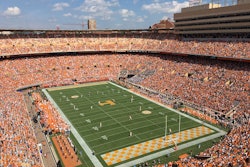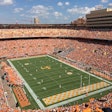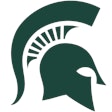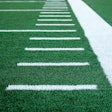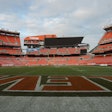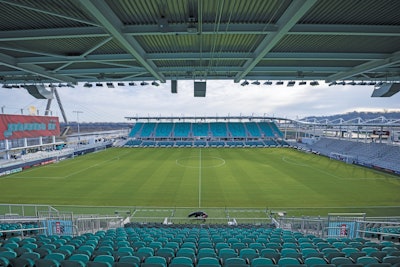
When the Kansas City Current hosted the Portland Thorns on March 16, 2024, the game not only opened the National Women’s Soccer League season for both teams; it marked the dawn of a new era for women’s sports.
That’s because the Current’s 5-4 victory christened 11,500-seat CPKC Stadium — regarded as the world’s first venue designed and built specifically for a women’s professional sports franchise. “It was an amazing moment to know that everybody who was in those stands — 11,500 people — were there for that team and that club and only there for that team and that club,” says Christina Franklin, director of interior design at Kansas City, Mo.-based Generator Studio, the architecture firm behind the $140 million project. “So, it’s one of those pinch-me moments for sure.”
It was a moment years in the making.
Angie Long, Chris Long and Brittany Mahomes had only shared ownership of the Current for 10 months when they announced Oct. 26, 2021, that the team would soon play in a privately funded soccer-specific stadium on a seven-acre site at Berkley Riverfront Park in Kansas City. The team, an NWSL expansion franchise assembled from assets of the defunct Utah Royals, had spent its inaugural 2021 season at Legends Park, home to the American Association of Professional Baseball’s Kansas City Monarchs, and its next two campaigns sharing 18,467-seat Children’s Mercy Park with Sporting KC of Major League Soccer — both venues located in nearby Kansas City, Kan.
Having a venue all to themselves, save for the occasional concert or special event (the U.S. Women’s National Team is scheduled to take the CPKC Stadium pitch in October, and the NCAA Women’s College Cup will be staged there in December), is a luxury enjoyed by Current players and fans alike. But is a stadium designed for women any different than any other stadium? Perhaps not at first glance. However, there are unmistakable subtleties that future designs — at least three additional NWSL teams are planning to move into purpose-built venues in the near future — must consider.

Right-sizing
The most conspicuous difference between a women’s venue and its multipurpose counterparts is scale.
“Not that women’s sports aren’t incredibly popular and growing,” Franklin says, “but as far as reach, it’s just slightly different still, so I think the scalability is something that’s really important to consider when working on that kind of facility.”
CPKC Stadium’s stakeholders considered years of ticket sales data from the Current’s previous stops to help right-size the dedicated venue, both in terms of individual and corporate interest. “You’re looking at the numbers and return on investment,” Franklin says. “You don’t want to overbuild. You just want to find that sweet spot so that it feels like fans are integrated into the action and atmosphere.”
Every location within CPKC’s seating chart — dominated by large grandstands hugging opposite sidelines — is within 100 feet of the playing field’s boundaries. “That is a little bit different approach,” Franklin says. “Larger stadiums are built for the maximum occupancy, whereas for some of these women’s facilities, we’re trying to have full seats on a regular basis. We wanted to make sure that people felt we were at capacity, because that adds to the energy of the event. Ultimately, if someone’s having that kind of experience, they’re more likely to become a fan for life. They just get more invested, and that’s great for any club.”
Of course, investment of real money into CPKC Stadium itself was a factor outside designers’ control. “Budget plays into that, and it comes down to the ownership group having that final say, but we wanted to make sure that the fan numbers were considered,” says Franklin, adding that she feels they collectively got the numbers right. “We also built in some flexibility for how they can grow in the future. By keeping the corners open, you’re able to fill those in, should you need to, with actual construction. Right now, we love that they’re open, because you have a visual connection to both the [Missouri] river and to the city, depending on which corner you’re looking through. And then there’s always the possibility of going upwards, as well, by adding another tier to the bowl if they want to go that direction in the future.
“But it was soccer first. It was women’s soccer, specifically. It wasn’t trying to be all things to other people.”

Player experience
Acknowledgement of the physical, psychological and cultural differences in how women train, recover and interact with teammates compared to men should help organize design priorities, according to Current head athletic trainer Georgia Vernardakis.
“The first thing I would say, for multiple reasons, is privacy,” Vernardakis says. “Now, do I think privacy is important in a men’s athletic training room? Absolutely. But I do think psychological differences have a huge effect on the comfort of a woman undressing versus a male undressing.”
Access to athletes in vulnerable states must be controlled as much as possible, Vernardakis advises. “It all starts at the door,” she says. “The door should not be a window. There shouldn’t be windows in the training room, and if there are, they should be grayed out. And the way the door opens is so important. You can’t really control who’s going to be walking past that door. What you can control is the way the door opens and closes, and making sure your equipment is set up in an ideal place, so if someone is walking past and the door is open at some point, they’re not going to see an exposed athlete.”
As director of medical for the NWSL’s Chicago Stars FC, Juliet Barnes looks forward to influencing the design of a new dedicated stadium for the club within the next five years. She advocates for adequate square footage in athletic training and recovery spaces. “With us having males on our staff, we either have to bring dividers with us into the medical space when we’re on the road, or we don’t allow males to come in at all,” Barnes says. “In these new female-facing spaces, you actually separate the training room from where the locker room is, and there is a separate entrance accessible to both males and females. That way, our male staff doesn’t have to just stay in the hallway and not do work until the game starts.
“It’s those little things that make a difference in our workflow. With the Chicago Stars, we have male massage therapists. Sometimes, if those spaces are too small, and because they’re in the locker room, we can’t have that person in that space. They have to be in the hallway doing massages on players, which we’ve had happen a million times over.”
Female physiological differences dictate such considerations as: one or more interior consultation rooms that can serve as private retreats for players who are self-conscious about changing clothes or about a particular treatment, or who are also nursing mothers; treatment tables that accommodate a pregnant player lying face down; and quick but discrete access via storage to feminine hygiene products in close proximity to the training room and playing field. Food prep areas and nutritional menus should reflect the specific lean protein and iron supplementation needs of women, as well.
Ideally, according to Vernardakis, stadium square footage would accommodate a play area for team members’ children. “Is there a space that’s safe for toddlers within eyesight of mom?” she asks.
At the same time, if a stadium or practice facility includes a weight room, it need not be made “petite,” as Barnes puts it. “Maybe our rack doesn’t need to be as big,” she says, “but when it comes to weight sizes, some of our athletes are lifting on par with male individuals.”
In fact, given that women can be more susceptible to injury — ACL injuries, in particular — weight training accommodations in a women’s facility should be every bit as robust as in any other facility. “With females, there is special consideration for the influence of the quad-to-hamstring ratio, hormones and the Q-angel of the knee to the pelvis, putting women at higher risk for some injuries, so incorporation of a preventive program is important,” Barnes says. “There’s no specific equipment that I can think of for an ACL preventive program that a female would use that a male wouldn’t also benefit from, and vice versa.”
Approaches may diverge during workout recovery. Says Barnes, “We’ve done alternative spaces, whether it’s a quiet space for meditation or a decompression room. Females tend to partake in those more than males.”
Other considerations may include specification of everything from shelves for leg shaving in shower stalls to bookshelves in team lounge areas. “At the end of the day, it’s about female-facing infrastructure and taking more into account than what has been historically,” Barnes says. “That can come down to the flow of the facility and getting feedback from the players on what makes sense for their day-to-day operation. What’s a day in the life of the athlete going to look like, and how best can we design that stadium or practice facility in a way that works best for them?”
Fan experience
While women’s stadiums must cater first and foremost to their permanent occupants, what about the welcome extended to regular guests — the fans?
Franklin points to one area of design commonality. “We need to make sure that there are wellness rooms that can accommodate female athletes within a stadium, but also female patrons, so they don’t feel like they’re excluded from being able to enjoy a game simply because they are in those first stages of being a mom,” she says.
It might be easy to assume that women dominate the fan base of a women’s franchise, but that’s not reality. Instead, the family-friendly nature (read affordability) of women’s sports drives certain hospitality design considerations — from food-and-beverage service and infrastructure to family restroom accommodations.
“You do see less alcohol consumption — not always, like a big Saturday night match, we’ll see high alcohol consumption — but to us, that does mean more food and non-alcoholic beverage” sales, says Sandeep Satish, chief commercial officer for the Current’s concessionaire Levy, which works with eight (soon to be 11) of the 14 NWSL franchises. “We do see more water, more energy drinks, more soda, more hot dogs, for example, than a typical MLS or NBA game.”
One transaction may involve the purchase of four chicken tender baskets, three waters and a beer, for example, versus a round of beers for a foursome of male fans.
“What that means for us is that the stands will have more potential cooking and storage needs, or we’ll add portables or hawkers to make sure we’re meeting that demand,” Satish says. “We’re not designing the NWSL with fewer kitchens. Absolutely not. In fact, the same number, if not more.”
It’s a design process that doesn’t happen overnight. “Kansas City got us involved very early in schematic design,” says Satish. “We were part of that project for almost three years, which is important to knowing where the kitchens go and how the queuing works, and what your pricing strategy is and your technology strategy. Those don’t happen within days. They take years to plan, and so we do get involved quite early, when possible.”
Though Levy doesn’t handle merchandise for the Current, it does offer those services through its Rank+Rally division. Satish reports that women, perhaps not surprisingly, have different retail tastes than men — think jewelry over jerseys. “Obviously, there’s more women’s apparel sold at women’s sports,” he says. “The real differences come in things like tchotchkes and scarves — that non-apparel space. I think women’s sports are also a lot more focused on different shopping experiences, so how you change thematically. There’s great potential for upsell and innovation.”
Stadium retail typically features a “nice mix” of concourse kiosks and built-in storefronts, Satish says, adding, “There’s demand for more technology in the retail space, and we’re seeing a lot of success with RFID checkout, which is great. The speed of service is so easy — grab whatever you want, put it in a bag, one transaction, tap your card, and then you pop your way out.”
In terms of premium hospitality experiences, the keyword again is scale. “We wanted to make sure that there was something for everyone,” Franklin says of CPKC Stadium. “Certainly, there’s a level of premium, but is it the most forward component of the stadium? No. We scaled down on the premium so that it felt like it was a stadium for all. Inclusivity is really important to the ownership group and to how we design, so we made sure that the stadium was accessible and approachable.”
That said, another of Franklin’s keywords comes into play here, too — flexibility. “This is where I think it’s really exciting,” says Satish of the women’s stadium concept. “Kansas City really put this on the map. Is there a robust corporate market? And their answer is an absolute yes. They’re selling out all of their suites and clubs and maybe in the future, they’ll add more. Some of the newer-designed venues that are looking to Kansas City for inspiration will say, ‘Maybe I can actually add a third, fourth or fifth club.’ Some of the MLS teams will launch with five clubs, whereas in women’s sports, maybe there’s only room for two or three clubs, but the demand is the same, if not more, for women’s sports, which is a great thing to see. Now, we just have to make sure there’s enough size and scope and space for adding more premium.”
As Satish eyes marketplace expansion at large, he sees tremendous potential for the proliferation of purpose-built stadiums for women. “We’re just so bullish,” he says. “I think it’s still at the tip of the iceberg.”
Adds Franklin, “I think oftentimes female athletes have gone into male-specific facilities and they’ve just had to make do, whereas this is for you. It is a mindset shift that has not really existed until recently, if you’re looking at the span of sports architecture. It’s fun to be a part of that.”
















![1 J9 A3684[37]](https://img.athleticbusiness.com/mindful/abmedia/workspaces/default/uploads/2025/08/1j9a368437.rJXRNqMrAV.psd?auto=format%2Ccompress&fit=max&q=70&w=400)






